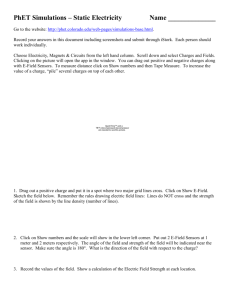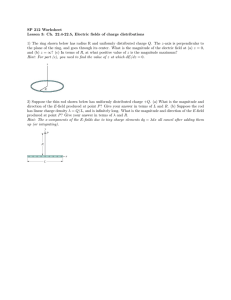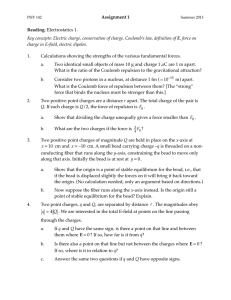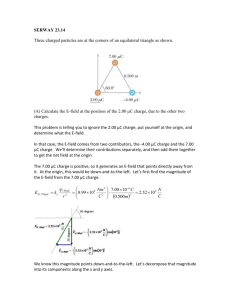Assignment 2 Reading ! 1.!
advertisement
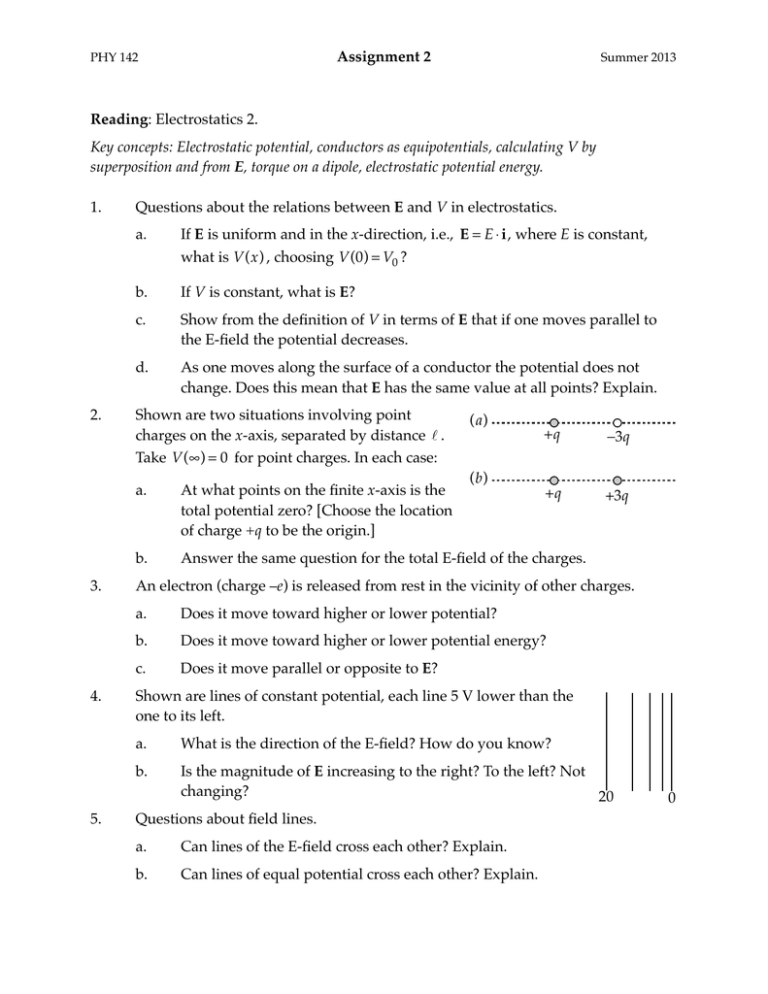
PHY 142! Assignment 2! Summer 2013 Reading: Electrostatics 2. Key concepts: Electrostatic potential, conductors as equipotentials, calculating V by superposition and from E, torque on a dipole, electrostatic potential energy. 1.! 2.! 3.! 4.! Questions about the relations between E and V in electrostatics. a.! If E is uniform and in the x-direction, i.e., E = E ⋅ i , where E is constant, what is V(x) , choosing V(0) = V0 ? b.! If V is constant, what is E? c.! Show from the definition of V in terms of E that if one moves parallel to the E-field the potential decreases. d.! As one moves along the surface of a conductor the potential does not change. Does this mean that E has the same value at all points? Explain. Shown are two situations involving point charges on the x-axis, separated by distance . Take V(∞) = 0 for point charges. In each case: (a) (b) +q −3q +q +3q a.! At what points on the finite x-axis is the total potential zero? [Choose the location of charge +q to be the origin.] b.! Answer the same question for the total E-field of the charges. An electron (charge –e) is released from rest in the vicinity of other charges. a.! Does it move toward higher or lower potential? b.! Does it move toward higher or lower potential energy? c.! Does it move parallel or opposite to E? Shown are lines of constant potential, each line 5 V lower than the one to its left. a.! What is the direction of the E-field? How do you know? b.! 5.! Is the magnitude of E increasing to the right? To the left? Not changing? 20 Questions about field lines. a.! Can lines of the E-field cross each other? Explain. b.! Can lines of equal potential cross each other? Explain. 0 PHY 142! 6.! Summer 2013 “Grounding” means connecting a conductor to the earth — a very large conductor which can accept or supply significant amounts of charge without changing its potential, which one usually chooses to be zero. “Shielding” means surrounding a region of space by a grounded conductor. Some examples: a.! b.! 7.! Assignment 2! An uncharged conducting spherical shell surrounds a point charge as q shown. Charge q appears on the outer surface of the shell. (Why?) What are the E-field and potential outside the shell? Does it matter whether the point charge is at the center of the shell’s cavity? q• Now we ground the shell. (The symbol shown is the icon for grounding.) The charge on the outer surface of the shell is now zero. What is the E-field outside the shell? q• c.! In this situation the interior of the shell is “shielded”. Suppose we bring up a second point charge +Q and place it near the shell but outside it. How does the grounded shell manage to remain at potential zero? d.! Is the force between the shell system and the charge +Q an attraction or a repulsion? Does this force depend in any way on q (its magnitude, its sign, or its location within the shell)? Questions about electrostatic potential energy. a.! The relation U = qV is sometimes interpreted as follows: A point charge q placed at a point where the potential due to other charges is V acquires potential energy U = qV . What is wrong with this statement? Correct it. 8.! b.! If V = 0 at infinite distance, then a system of charges that has total energy (kinetic plus potential) greater than zero is unbound. Explain why. c.! One describes the total potential energy of a system of charges in two ways: (1) as the work done by an agent who brings the charges in from infinite distance and places them at rest at their final locations; (2) as the negative of the work done by electrostatic forces while the system is assembled. Explain why these give the same result. Shown is a conductor in the shape of an ellipsoid. All charges are at rest. a.! b.! Compare the potential at the surface at the points shown. Compare the magnitude of E at those points. b a c d PHY 142! 9*.! Assignment 2! A pair of thin concentric conducting spherical shells, of radii a and b, are arranged as shown. The inner shell carries charge +q while the total charge on the outer shell is +Q. Give answers in terms of these quantities. a.! Find the magnitude of the E-field E(r) where r Summer 2013 +Q +q a b is the distance from the center, in three regions: I, r > b ; II, a < r < b ; III, r < a . ! Ans: I: E = k(Q + q)/r 2 ; II: E = kq/r 2 ; III: E = 0 . b.! Write the formula for the potential in those three regions, taking V(∞) = 0 . Ans: I: V = k(Q + q)/r; II: V = kQ/ b + kq/r; III: V = kQ/ b + kq/ a . c.! ! 10.! Suppose small holes are drilled through the spheres along the dotted line in the figure, and an electron (charge –e) is released from rest in the hole at the top of the outer shell (distance r = b from the center). What is the kinetic energy of the electron when it is at the center of the spheres? ⎡1 1 ⎤ Ans: K(r = 0) = keq ⎢ − ⎥ . ⎣a b⎦ Conducting spheres A and B are separated by a distance large compared to their radii RA and RB . Charge Q is placed on A, while B is uncharged. Take V(∞) = 0 . a.! What is the potential at the surface of A? b.! A long wire is connected between the spheres. How much charge flows to B? What is the potential at the surface of the spheres now? c.! What is the magnitude of the E-field at the surface of A? Of B? Express the answers in terms of the potential you found in (b). d.! Suppose the potential at the surface of B is 1000 V. Find the value of RB for which the E-field magnitude at the surface is 106 V/m. 11.! A coaxial cable is made of concentric cylindrical conductors as shown. The inner conductor is a wire of radius a; the outer conductor is a sheath of inner radius b. The wire carries uniform positive charge per unit length λ . The sheath is grounded. Also shown is a cross section, with a point (indicated by the dot) at distance r from the symmetry axis. • PHY 142! 12*.! Assignment 2! Summer 2013 a.! What is the charge per unit length on the inner surface of the sheath? What is the direction of E at the indicated point? How do you know? b.! Use Gauss’s law (with a cylindrical surface passing through the point) to find the magnitude of the E-field at the point indicated. Ans: E = 2kλ /r . c.! Since the sheath is grounded, V = 0 on it. Find the potential on the wire. Ans: V(a) = 2kλ ⋅ ln(b/ a) .! Questions about accelerating particles through potential differences. a.! Using the formula K = 12 mv 2 from Newtonian mechanics, find the potential difference V through which a proton (charge +e) at rest must be accelerated to reach the speed of light, c. Ans: V = mc 2 / 2e . b.! Actually the correct formula for kinetic energy (from special relativity) is ! ! ! Use the binomial approximation to show that if v /c << 1 this formula ⎡ ⎤ 1 K = mc 2 ⎢ − 1⎥ . ⎢⎣ 1 − v 2 /c 2 ⎥⎦ gives the Newtonian formula as an approximation. c.! The correct formula shows that it would take an infinite amount of energy to accelerate a particle to speed c, so that is impossible. Find the ratio v /c for a proton accelerated through the potential difference you found in (a). Ans: v /c = 5/9 . 13*.! Three point charges are fastened at the corners of an equilateral triangle of side a as shown. The two charges at the bottom corners are +q each. Give answers in terms of k, q and a. a.! b.! Let the charge at the top also be +q. It is released from rest while the others remain fixed. • +q • • +q i.! Describe its motion. ii.! When it is far from the others, what is its kinetic energy? [What are the initial and final potential energies?] Now let the charge at the top be –q, and again it is released from rest. i.! Describe its motion. ii.! What is its maximum kinetic energy? [At what point in the motion is the potential energy the smallest?] PHY 142! 14.! Assignment 2! Summer 2013 Shown is a small dipole in an E-field due to other charges. The line between the charges makes angle θ with the direction of the field. Assume at first that the field is uniform. +q d θ −q a.! What is the magnitude of the torque on this dipole? Express it in terms of the dipole moment, which has magnitude p = qd . b.! The work done by a torque τ in rotating an object through angle dθ is E dW = τ ⋅ dθ , where τ is positive if it is counter-clockwise (so that it rotates the object in the direction of increasing θ ). What is the work done by the torque on the dipole in rotating the it from θ = π / 2 to some final angle θ ? c.! Since the electrostatic force that causes this torque is conservative, the work done is the negative of the change in potential energy, U(θ ) . Choose U(π / 2) = 0 and show that U(θ ) = −p ⋅ E , where p is the dipole moment. d.! Now suppose the E-field not uniform. Let p be in the x-direction so that U = −pEx . Show that if Ex varies with x, there is a force on the dipole given by Fx = p ⋅ dEx /dx . [Recall that in general Fx = −dU(x)/dx .] Discuss the direction of this force. 15.! A proton (charge +e , mass m) is at the surface of a large conducting sphere of radius R which carries charge +Q . [The small proton charge does not appreciably alter the distribution of charge on the sphere.] The proton is released from rest. a.! When the proton is at distance R above the sphere’s surface, what is its kinetic energy? Ans: keQ/ 2R . b.! Instead of the sphere we have a large flat charged plate with the same magnitude of E at its surface as that of the sphere. When the proton is at distance R from the plate, what is its kinetic energy? Ans: keQ/R . c.! Explain why the answer to (a) is smaller than the answer to (b).


